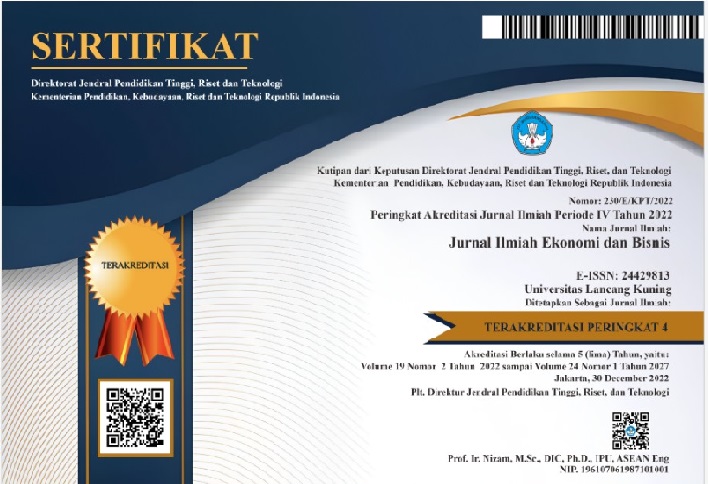PENGARUH KEADILAN ORGANISASI TERHADAP KEPERCAYAAN ORGANISASI (STUDI EMPIRIS PADA SELURUH SEKOLAH TINGGI ILMU EKONOMI DI KOTA PEKANBARU
DOI:
https://doi.org/10.31849/jieb.v14i2.878Abstract
Abstract: The purpose of this research is to know the effect of distribution of justice,
procedural justice, and interactical juastice to organizational trust. Population in this research
is all lecturer at high school of economics. The sample collection of 104 people. Data
processing is done by structural equation modeling analysis using WarpPLS 5.0 software. The
results showed that organizational justice had positive effect on organizational trust. This
explains that subordinates who feel justice in their organization will lead them to believe in
their organization.
Keywords: Distributive Justice, Procedural Justice, Interactional Justice, Organizational
Trust
References
kepercayaan organisasi terhadap
organizational silence kepuasan
kerja dan komitmen organisasi”.
Laporan Hasil Penelitian
Mandiri.
Abdillah, W. dan J. Hartono. (2015)
Partial Least Square (PLS) :
Alternatif Structural Equation
Modeling (SEM) dalam
Penelitian Bisnis. Yogyakarta :
Andi.
Agarwal, U.A. (2014), “Linking justice,
trust and innovative work
behavior to work engagement”,
Personnel Review, Vol. 43 No. 1,
pp. 41-73.
Aryee, S., Budhwar, P.S. and Chen, Z.X.
(2002), “Trust a mediator of the
relationship between
organizational justice and work
outcomes: test of a social exchange
model”, Journal of Organizational
Behavior, Vol. 23 No. 3, pp. 267-
285.
Bidarian, S. and Jafari, P. (2012) "The
relationship between
organizational justice and
organizational trust", Procedia -
Social and Behavioral Sciences,
Vol. 47, pp. 1622-1626.
Bies, R.J. and Moag, J.S. (1986),
“Interactional justice:
communication criteria of
fairness”, Research on Negotiation
in Organizations, Vol. 1, pp. 43-
55.
Blau, P.M. (1964), Exchange And Power in
Social Life, Wiley, New York, NY.
Cheng, S.Y. (2014), “The mediating role of
organizational justice on the
relationship between
administrative performance
appraisal practices and
organizational commitment”, The
International Journal of Human
Resource Management, Vol. 25
No. 8, pp. 1131-1148.
Cohen-Charash, Y. and Spector, P. (2001),
“The role of justice in
organizations: a meta-analysis”,
Organization Behavior and
Human Decision Processes, Vol.
86 No. 2, pp. 278-321.
Colquitt, J.A. (2001), “On the
dimensionality of organizational
justice: a construct validation of a
measure”, Journal of Applied
Psychology, Vol. 86 No. 3, pp.
386-400.
Cropanzano, R. and Mitchell, M.S.
(2005), “Social exchange theory:
an interdisciplinary review”,
Journal of Management, Vol. 31
No. 6, pp. 874-900.
Cropanzano, R., Prehar, C.A. and Chen,
P.Y. (2002), “Using social
exchange theory to distinguish
procedural from interactional
justice”, Group and Organization
Management, Vol. 27 No. 3, pp.
324-351.
Davis, J.H., Schoorman, F.D., Mayer,
R.C. and Tan, H.H. (2000), “The
trusted general manager and
business unit performance:
empirical evidence of a
competitive advantage”, Strategic
Management Journal, Vol. 21
No. 5, pp. 563-576.
Elamin, A.M. and Tlaiss, H.A. (2015),
“Exploring the relationship
between organizational
citizenship behavior and
organizational justice in the
Islamic Saudi Arabian context”,
Employee Relations, Vol. 37 No.
1, pp. 2-29.
Ellonen, R., Blomqvist, K., and
Puumalainen, K. (2008), "The
role of trust in organizational
innovativeness", European
Journal of Innovation
Management, Vol. 11 Iss 2 pp.
160 – 181
Fard, P.G., and Karimi, F. (2015) "The
Relationship between
Organizational Trust and
Organizational Silence with Job
Satisfaction and Organizational
Commitment of the Employees
of University". International
Education Studies, Vol. 8 No. 11,
pp. 219-227.
Ghozali, I. dan Fuad (2012) Structural
Equation Modeling : Teori,
Konsep, dan Aplikasi Dengan
Lisrel 8.80, Semarang : UNDIP
Press.
Greenberg, J. (1987), “A taxonomy of
organizational justice theories”,
Academy of Management Review,
Vol. 12 No. 1, pp. 9-22.
Gupta, V. and Singh, S. (2013), “An
empirical study of the
dimensionality of organizational
justice and its relationship with
organizational citizenship
behaviour in the Indian context”,
The International Journal of
Human Resource Management,
Vol. 24 No. 6, pp. 1277-1299.
Hair, J. F., M. Sarstedt, C. M. Ringle, dan J.
A. Mena. (2012) “An Assessment
of the Use off Partial Least
Squares Structural Equation
Modeling in Marketing Research”,
Journal of the Academy of
Marketing Science. Vol. 40 No. 1,
pp. 414-433.
Hair, J. F., M. Sarstedt, L. Hopkins, V. G.
Kuppelwieser. (2014) “Partial
Least Squares Structural Equation
Modeling (PLS-SEM): An
Emerging Tool in Business
Research”. European Business
Review. Vol. 26 No. 2, pp. 106-
121.
Hartono J. (2011) Konsep dan Aplikasi
Structural Equation Modeling
Berbasis Varian dalam Penelitian
Bisnis. Yogyakarta : UPP STIM
YKPN.
Hartono. J. (2015) Metodologi Penelitian
Bisnis : Salah Kaprah dan
Pengalaman-Pengalaman. Edisi 6.
Yogyakarta : BPFE.
James, K. (1993), “The social context of
organizational justice: cultural
intergroup, and structural
effects”, in Cropanzano, R. (Ed.),
Justice in the workplace,
Erlbaum, Hillsdale, NJ, pp. 21-
50.
Latan, H. dan I. Ghozali. (2012) Partial
Least Squares : Konsep, Teknik
dan Aplikasi Menggunakan
Program SmartPLS 2.0 M3.
Semarang : UNDIP Press.
Leventhal, G.S. (1980), “What should be
done with equity theory? New
approaches to the study of
fairness in social relationshipsin
Gergen, K.J., Greenberg, M.S.
and Willis, R.H. (Ed.), Social
Exchange: Advances in Theory
and Research, NY Plenum Press,
New York, pp. 27-55.
Liu, N.-T. and Ding, C.G. (2012),
“General ethical judgments,
perceived organizational support,
interactional justice, and
workplace deviance”, The
International Journal of Human
Resource Management, Vol. 23
No. 14, pp. 2712-2735.
McAllister, D.J. (1995), “Affect-and
cognition-based trust as
foundations for interpersonal
cooperation in organizations”,
Academy of Management
Journal, Vol. 38 No. 1, pp. 24-
59.
McCune, J. (1998), “The elusive thing
called trust”, Management
Review, Vol. 87 No. 7, pp. 11-16.
Mayer, R.C., Davis, J.H. and Schoorman,
F.D. (1995), “An integrative
model of organizational trust”,
Academy of Management Review,
Vol. 20 No. 3, pp. 709-734.
Mishra, J. and Morrissey, M.A. (1990),
“Trust in employee/employer
relationships: a survey of West
Michigan managers”, Public
Personnel Management, Vol. 19
No. 3, pp. 443-485.
Moye, M.J. and Henkin, A.B. (2006),
“Exploring associations between
employee empowerment and
interpersonal trust in managers”,
Journal of Management
Development, Vol. 25 No. 2, pp.
101-117.
Mustafa EQ, Z. (2009) Mengurai Variabel
hingga Instrumen, Graha Ilmu,
Yogyakarta.
Niehoff, B. and Moorman, R.H. (1993),
“Justice as a mediator of the
relationship between methods of
monitoring and organizational
citizenship behavior”, Academy of
Management Journal, Vol. 36 No.
3, pp. 527-556.
Noe, R.A., Hollenbeck, J.R., Gerhart, B.,
and Wright, P.M. (2011)
Manajemen Sumber Daya
Manusia ; Mencapai Keunggulan
Bersaing, Edisi Keenam, Buku
Dua, Terjemahan, Salemba Empat,
Jakarta.
Redman, T., Dietz, G., Snape, E. and van
der Borg, W. (2011), “Multiple
constituencies of trust: a study of
the Oman military”, The
International Journal of Human
Resource Management, Vol. 22
No. 11, pp. 2384-2402.
Robinson, S.L. (1996), “Trust and breach of
the psychological contract”,Administrative Science
Quarterly, Vol. 41, pp. 574-599.
Sari, R.N., Anugerah, R., Yusralaini and
Gusrifan, H. (2013) "The
Mediating Effects of Feedback
and Procedural Justice on the
Relationship between Formal
Performance Evaluation System
and Trust between Superior and
Subordinate Managers",
Mediterranean Journal of Social
Sciences, Vol. 4 No. 10, pp. 497-
504.
Sekaran, U. (2006) Metode Riset Bisnis,
Salemba Empat, Jakarta.
Solihin, M. dan D. Ratmono. (2013).
Analisis SEM-PLS dengan
WarpPLS 3.0, Yogyakarta : Andi.
Suliman, A. (2013), “Organizational
justice and innovation in the
workplace: the case of the UAE”,
Journal of Management
Development, Vol. 32 No. 9, pp.
945-959.
Sugiyono (2011) Metode Penelitian
Bisnis. Alfabeta. Bandung.
Tlaiss, H.A. dan Elamin, A.M. (2015)
“Exploring organizational trust
and organizational justice among
junior and middle managers in
Saudi Arabia”. Journal of
Management Development, Vol.
34 No. 9, pp. 1042 – 1060
Wat, D. and Shaffer, M.A. (2005),
“Equity and relationship quality
influences on organizational
citizenship behaviors: the
mediating role of trust in the
supervisor and empowerment”,
Personnel Review, Vol. 34 No. 4,
pp. 406-422.
Whitener, E.M. (1998), “The impact of
human resource activities on
employee trust”, Human Resource
Management Review, Vol. 7 No. 4,
pp. 389-404.
Wibowo, H., S. (2014). SEM With Lisrel,
Modul Pelatihan Pusat Pendidiikan
dan Pelayanan (P3M) Universitas
Indonesia, Depok.
Wong, Y.T. (2012), “Job security and
justice: predicting employees’ trust
in Chinese international joint
ventures”, The International
Journal of Human Resource
Management, Vol. 23 No. 19, pp.
4129-4144.
Wong, Y.T., Wong, C.S. and Ngo, H.Y.
(2002), “Loyalty to supervisor and
trust in supervisor of workers in
Chinese joint ventures: a test of
two competing models”, The
International Journal of Human
Resource Management, Vol. 13
No. 6, pp. 883-900.












 This work is licensed under a Attribution 4.0 International (CC BY 4.0)
This work is licensed under a Attribution 4.0 International (CC BY 4.0) 